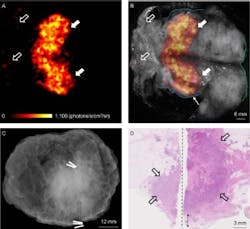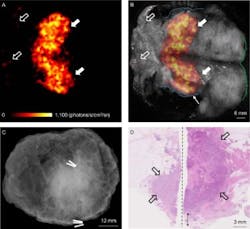Optical and molecular imaging pair to guide breast-conserving surgery
Breast-conserving surgery (BCS) is the primary treatment for early-stage breast cancer, but more accurate techniques are needed to assess resection margins during surgery to avoid the need for follow-up surgeries. Now, in an in-human study, researchers at King's College London (England) have provided a possible solution using Cerenkov luminescence imaging (CLI), which combines optical and molecular imaging by detecting light emitted by the positron emission tomography (PET) radiotracer F-18-fluorodeoxyglucose (F-18-FDG). CLI's high-resolution and small-sized imaging equipment make it a promising technology for assessing tumor margins during breast tumor surgery.
Related: Two views at once: Combined imaging boosts biomedical research
Approximately one in five women who undergo BCS (also known as lumpectomy) require repeat surgery because of inadequate excision of the tumor during the initial surgical procedure, explains Arnie D. Purushotham, MD, professor at King's College London, who led the work. "By accurately assessing tumor resection margins intraoperatively with CLI, surgeons may be able to completely clear the cancer with a single operation, thereby reducing the number of breast cancer patients requiring a second, or even third, surgical procedure. Ultimately, this could lead to improved patient care and reduced healthcare costs if confirmed in larger clinical studies," he says.
This study included 22 patients with invasive breast cancer. F-18-FDG was injected 45-60 minutes before surgery. Immediately after the excision of tumors, specimens were imaged intraoperatively in an investigational CLI imaging system. The first 10 patients were used to optimize the imaging protocol, and the remaining 12 were included in the analysis dataset. Ten of the 12 patients had an elevated tumor radiance on CLI, and agreement among raters on margin distance was good. Sentinel lymph nodes, which used technetium-99m to facilitate identification, were detected and biopsied in all patients.
F-18-FDG CLI is, therefore, a promising, low-risk technique for intraoperative assessment of tumor margins in BCS. A randomized controlled trial will evaluate the impact of this technique on re-excision rates.
Full details of the work appear in the Journal of Nuclear Medicine; for more information, please visit http://dx.doi.org/10.2967/jnumed.116.181032.

